
Geburtsstein für Januar: Das Jahr beginnt mit Granat
Wenn Ihr Geburtstag das neue Jahr einläutet, wird es Sie freuen zu hören, dass der Granat Ihr Geburtsstein für Januar ist. Der Januar ist der Monat des Neuanfangs und der positiven Zukunftsaussichten; Granat spiegelt diese Helligkeit und den Umfang der Möglichkeiten wider.
Der Name Januar leitet sich von Janus ab, dem Gott der Anfänge und Enden in der römischen Mythologie. Janus hat zwei Gesichter, die jeweils in die Vergangenheit oder Zukunft blicken.
In diesem Sinne betrachten wir den traditionellen Januar-Geburtsstein Granat mit seinen verschiedenen Bedeutungen, seiner Geschichte und seinen Verwendungsmöglichkeiten. Außerdem stellen wir einige moderne Alternativen vor, mit denen Sie Ihr Januar-Baby feiern können!
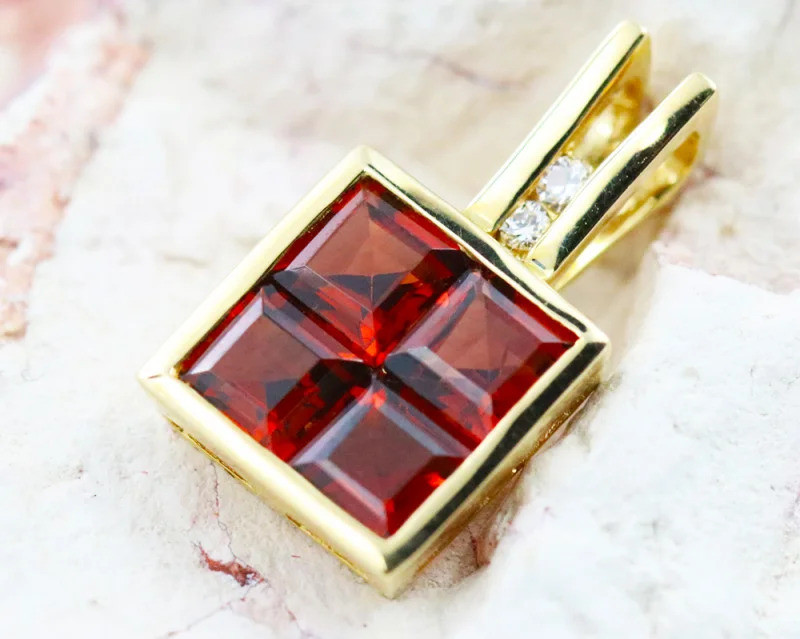
Bedeutung des Geburtssteins für Januar: Granatsymbolik
Beginnen wir mit der Symbolik: Der Granat, der Geburtsstein für Januar, steht im Allgemeinen für Freundschaft, Wärme und Leidenschaft.
Eine weitere Bedeutung dieses Halbedelsteins für den Januar ist der Schutz, eine Verwendung, die bis in die Antike zurückreicht.
Historische und kulturelle Bedeutung des Geburtssteins Granat für Januar
Der Geburtsstein für Januar ist vor allem durch sein leuchtendes Rot bekannt, es gibt ihn aber auch in verschiedenen anderen Farbtönen, von Rosa oder Orange bis hin zu Grün oder Lila.
Der Granat ist auch der traditionelle Edelstein zum zweiten Hochzeitstag .
Der Name „Granat“ leitet sich vom mittelalterlichen lateinischen Begriff granatus ab, der „Granatapfel“ bedeutet, weil kleine rote Granatkristalle Granatapfelkernen ähneln.
 Oben abgebildet: Griechische Halskette und Ohrringe aus Granat und Achat aus dem 1. Jahrhundert v. Chr. | Bildnachweis: Metropolitan Museum of Art , Gemeinfrei
Oben abgebildet: Griechische Halskette und Ohrringe aus Granat und Achat aus dem 1. Jahrhundert v. Chr. | Bildnachweis: Metropolitan Museum of Art , Gemeinfrei
Granate in der Antike
Die Verwendung von Granaten geht auf die Bronzezeit (ca. 3300 v. Chr. bis 1200 v. Chr.) zurück. Damals wurde der Januar-Geburtsstein für Schleifmittel, Bestattungen und königlichen Schmuck verwendet. Die Antike nutzte Granate auch als Talismane zum Schutz im Krieg und auf Reisen, da sie glaubten, der Edelstein würde Licht in die Dunkelheit bringen.
Die alten ägyptischen Pharaonen trugen im Leben und im Tod rote Granatketten und wurden mit diesen Juli-Geburtssteinen begraben. Die Ägypter glaubten, Granate symbolisierten das Leben.
Im alten Rom stempelten Beamte Dokumente mit Siegelringen aus geschnitztem Granat. Römer nutzten Granat zum Schutz, wenn sie reisten, in die Schlacht zogen oder Krankheiten wie die Pest vermieden.
Ein antiker griechischer Mythos über die Herkunft des Granats handelt von Persephone, der Göttin der Vegetation, die bekanntlich von Hades, dem Gott der Unterwelt, entführt und mit ihm verheiratet wurde.
Als Zeus Hades aufforderte, Persephone zurückzugeben, gab dieser Persephone einen Granatapfel. Nachdem sie die Granatapfelkerne gegessen hatte, war sie für immer mit Hades verbunden und verbrachte die Hälfte jedes Jahres (Herbst bis Winter) in der Unterwelt.
So wurden Granatäpfel und ähnlich aussehende Granate mit getrennten Liebenden, der Ewigkeit und den regenerativen Zyklen der Erde in Verbindung gebracht.
Alte Namen für Granate
Vor „Granat“ gab es für Granate (und ähnliche rote Edelsteine) auch andere alte Bezeichnungen wie:
Der griechische Begriff Anthrax (vom griechischen Philosophen Theophrastus) bedeutet „glühende Glut“
Der lateinische Begriff carchedonius (vom römischen Schriftsteller Petronius) stammt vom griechischen Namen Carchedonia für Karthago, eine antike phönizische Stadt
Das arabische Yaqut , verwendet für Granat, Rubin oder Saphir
Das Sanskrit und Hindu-Wort „raktamani “ bedeutet „blutrotes kostbares Juwel“.
Die lateinischen Begriffe Carbunculus oder Carbunkel (vom römischen Gelehrten Plinius dem Älteren) bedeuten „brennende Kohle“
Viele frühe Granatnamen bezogen sich auf ihre feurigen Eigenschaften: rote Farbe, Funkeln und Hitzebeständigkeit.
Viele rote Steine wurden in der Antike jedoch als „Karfunkel“ bezeichnet, sodass es schwer zu sagen ist, ob es sich bei ihnen wirklich um Granate handelte. Auch heute noch werden rote Granat -Cabochons manchmal als Karfunkel bezeichnet.
 Oben abgebildet: Ostgotischer (germanischer) Granatring aus dem 5. Jahrhundert (Frühmittelalter) mit eingravierter Schraffur | Bildnachweis: Walters Art Museum, gemeinfrei
Oben abgebildet: Ostgotischer (germanischer) Granatring aus dem 5. Jahrhundert (Frühmittelalter) mit eingravierter Schraffur | Bildnachweis: Walters Art Museum, gemeinfrei
Religiöse und spirituelle Bedeutung
Der Granat, der Geburtsstein für Januar, hat verschiedene religiöse oder spirituelle Bedeutungen und heilende Eigenschaften.
Christentum :
In der Bibel wird Granat (aus dem hebräischen Wort nophek abgeleitet) in geistlichen oder königlichen Schmuckstücken und als Leuchtfeuer auf der Arche Noah erwähnt.
Einige Bibelgelehrte interpretierten diese Erwähnungen von Granaten, indem sie die blutähnliche Farbe des Edelsteins und seine Fähigkeit, in der Dunkelheit zu leuchten, als Symbol für das Opfer Jesu Christi, Gottes göttliches Wort, die Hingabe an Gott oder die christliche Spiritualität im Allgemeinen hervorhoben.
Geistliche im Mittelalter (etwa 475 bis 1450 n. Chr.) trugen häufig Granat-Edelsteine. Die Ringe katholischer Bischöfe repräsentierten ihre religiöse Autorität und symbolisierten ihre „Vermählung“ mit der Kirche.
Einige christliche Gelehrte behaupteten sogar, dass die Einnahme von gemahlenem Karbunkel einem Kräfte, ehrenhafte Urteile und spirituelles Erwachen verleihen würde.
Heiden :
Fränkische Heiden wie Childerich I. glaubten, dass rote Edelsteine wie Granate Liebe, Leben und Fruchtbarkeit symbolisierten, und verwendeten sie für Schnitzereien von Göttern wie Eros, Freia und Isis.
Islam :
Der Koran erwähnt sieben Himmel im Jenseits, wobei der sechste Himmel aus Granaten und Rubinen besteht. Edelsteine symbolisierten im Koran oft den Segen Allahs.
Hinduismus :
Hinduistische Energieheiler verwenden Granat als Wurzel- oder Kronenchakra -Stein . Vedische Astrologen bringen roten Granat auch mit „Rahu“ oder Mars in Verbindung, dem Planeten der Energie und des Krieges, und glauben, dass Granate die negativen Auswirkungen des Mars ausgleichen.
Insgesamt haben Granate viele Bedeutungen, sowohl für die Heilung als auch für den Schaden.
Einige Indianerstämme und asiatische Stämme verwendeten rote Granate als Kugeln, um tödliche Verletzungen zu verursachen, während mittelalterliche Ärzte verschiedene Leiden mit Granaten behandelten, darunter Fieber, Wunden, Gelbsucht und sogar die Beulenpest.
Geologie und Zusammensetzung des Januarsteins Granat
Granate sind eine große, komplexe Gruppe von Mineralien mit drei Kategorien. Die beiden Hauptgruppen von Granaten in Edelsteinqualität sind Pyralspit und Ugrandit:
Pyralspit : Aluminiumreiche Silikate; Enthält die Arten Pyrop , Almandin und Spessartin
Ugrandit : Kalziumreiche Silikate; Enthält die Arten Uvarovit , Grossular und Andradit
Viele Granatarten sind Mischungen dieser Arten, oft innerhalb derselben Serie, manchmal aber auch kreuz und quer zwischen den Serien.
Lassen Sie uns zunächst die Pyralspitarten dieser Geburtssteine für Januar durchgehen.
Pyrop
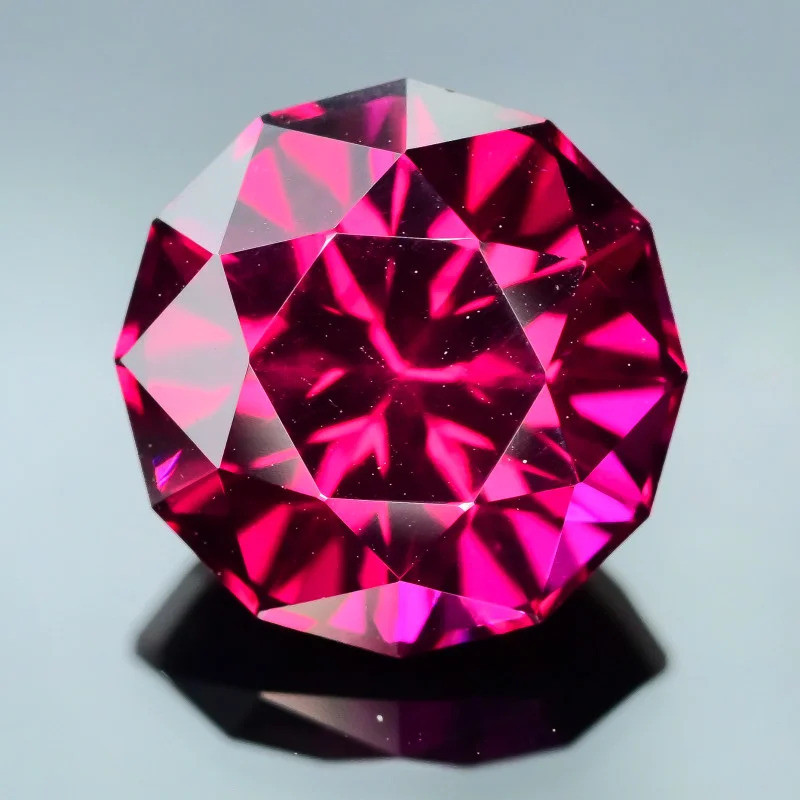 Abbildung oben: Facettierter Umbalit-Granat aus Mosambik
Abbildung oben: Facettierter Umbalit-Granat aus Mosambik
Pyrop-Granate sind die bekannteste rote Granatsorte und bestehen aus Magnesium-Aluminium-Silikaten, die für ihre blutrote oder granatapfelfarbene Farbe bekannt sind. Pyrop-Granate sind die einzigen durchgehend roten Granate, obwohl ihre genauen Farbtöne mit Untertönen von Lila, Orange, Schwarz und Braun variieren.
Zu den Pyrop-Geburtssteinen gehören:
Chrompyrop
Pastell Pyrop
Mosambik-Granate
Sterngranat
Umbalit
Traubengranat
Almandin
 Abbildung oben: Facettierter Rhodolith-Granat
Abbildung oben: Facettierter Rhodolith-Granat
Almandin ist eine weitere äußerst beliebte Granatart. Dieses Eisenaluminiumsilikat ist etwas härter als Pyrop. Seine Farben reichen von tiefem Rot und Purpurrot bis hin zu bräunlichen Tönen.
Zu den Almandin-Sorten gehören:
Mosambik-Granate
Rhodolith
Malaya (Malaia) Granat
Sterngranat
Umbalit
Traubengranat
Proteus-Granat
Spessartin
 Abbildung oben: Facettierter Mandarin-Granat
Abbildung oben: Facettierter Mandarin-Granat
Spessartit-Granate sind die einzigartigere Pyralspit-Art, bekannt für ihre gelb- bis orangefarbene Färbung und sehr hohe Brillanz. Zu den Sorten dieses Mangan-Aluminium-Silikats gehören:
Malaya (Malaia) Granat
Kaschmir
Katzenauge Spessartin Granat
Umbalit
Jetzt kommen wir zur Ugrandit-Art!
Uwarowit
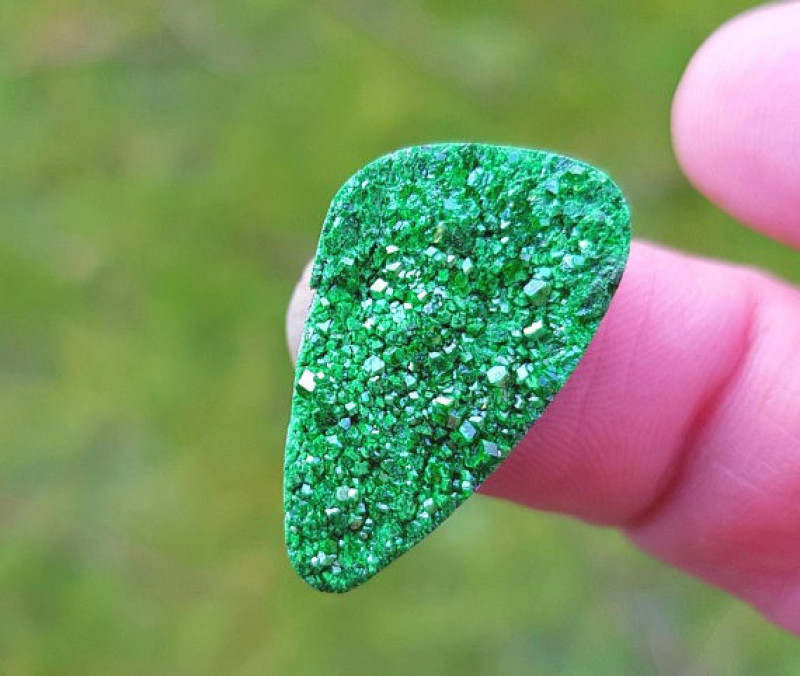 Abbildung oben: Uvarovit-Granat- Druse
Abbildung oben: Uvarovit-Granat- Druse
Uwarowit ist ein Calcium-Chrom-Silikat und die seltenste Granatart in Edelsteinqualität. Er ist zudem der einzige Granat, der durchgehend grün ist und von mittleren bis dunklen Farbtönen reicht.
Grossular
 Abbildung oben: Silberring mit grünen Tsavorit-Granaten und Zirkonia
Abbildung oben: Silberring mit grünen Tsavorit-Granaten und Zirkonia
Grossular-Granate sind Calcium-Aluminium-Silikate, wobei Eisen manchmal einen Teil des Calciums und Aluminiums ersetzt. Sie sind bekannt für ihre breite Farbpalette und die einzigen farblosen Varianten in Edelsteinqualität.
Grossular-Granat-Varietäten sind:
Kaisergranat
Minze (oder Merelani-Minze) Granat
Leuko-Granat
Umbalit
Einige betrachten Hydrogrossular-Granat als eine Grossular-Variante, aber unter Gemmologen ist dies umstritten.
Andradit
 Abbildung oben: Goldring mit grünem Demantoid-Granat und rosa Diamanten
Abbildung oben: Goldring mit grünem Demantoid-Granat und rosa Diamanten
Andradite sind Calcium-Eisen-Silikate mit außergewöhnlich hoher Dispersion (buntes Funkeln) und Brillanz (weiße Lichtblitze). Obwohl sie nicht so beliebt und selten sind wie andere Arten, gibt es einige begehrte Varianten von Andraditen, wie zum Beispiel:
Alle diese Varianten tragen zu dem wunderschönen Regenbogen aus Granatfarben und optischen Effekten bei, die diese Geburtssteine für Januar aufweisen!
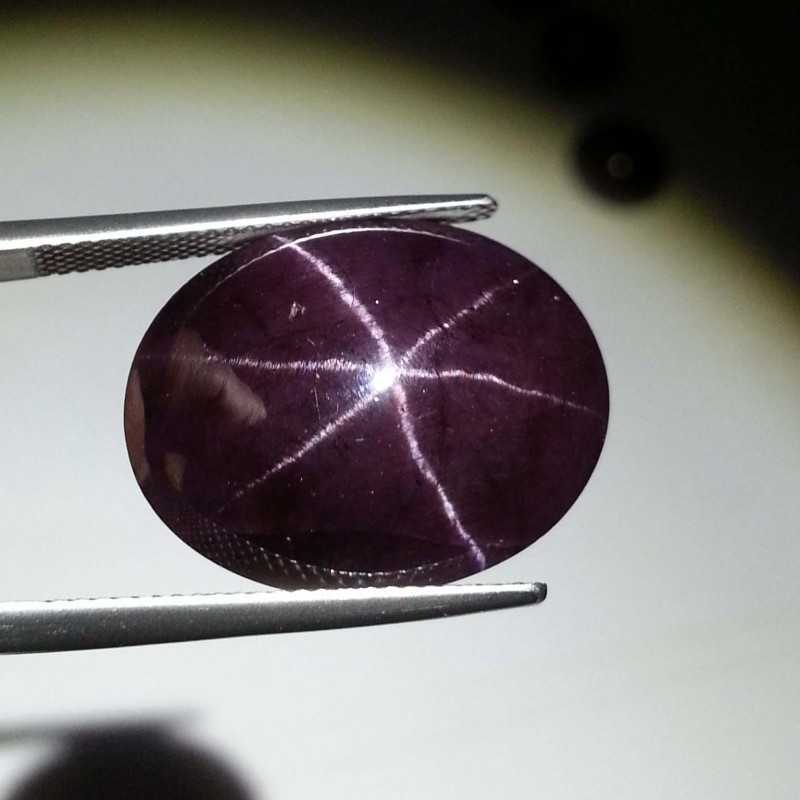 Abbildung oben: Lila Sterngranat
Abbildung oben: Lila Sterngranat
Faszinierende Farben und Variationen
Welche Farbe hat der Geburtsstein für Januar? Granat ist meist rot, es gibt ihn aber in vielen verschiedenen Farben, und einige Varianten haben sogar besondere optische Effekte.
Granate nach Farbe
Die Farbe des Geburtssteins für Januar kann praktisch jeden Farbton annehmen, Blau ist jedoch äußerst selten und kommt nur bei einigen farbwechselnden Varianten vor.
Die beliebtesten Varianten für jede Farbe dieses Geburtssteins für Januar sind:
Rot : Pyrop
Orange : Mandarin-Granat
Gelb : Mali-Granat
Grün : Demantoid oder Tsavorit
Lila : Umbalit oder Traubengranat
Rosa : Rhodolith
Farblos : Nur Leukogranate (Grossular)
Schwarz : Melanit
Neben unterschiedlichen Farben sind Granat-Geburtssteine für den Januar auch mit einzigartigen optischen Effekten erhältlich.
Optisch phänomenale Granate
Zu den Granat-Geburtssteinen mit optischen Phänomenen gehören:
Sterngranat : Zeigt einen 4-, 6- oder sogar 12-strahligen „Stern“ aus reflektiertem Licht durch Asterismus; normalerweise schwarz, braun oder dunkel purpurrot, kann aber verschiedene Rot- bis Purpurtöne aufweisen, darunter rötlich-schwarz und schwärzlich-purpur
Katzenaugen-Granat : Reflektiert einen Lichtstrahl, der einem Katzenauge ähnelt, durch Chatoyancy aufgrund paralleler Einschlüsse von nadelartigen Fasern oder hohlen Röhren; immer Spessartin
Farbwechselnder Granat : Ändert die Farbe bei unterschiedlicher Beleuchtung, normalerweise UV- (Sonnenlicht) und Glühlampenlicht; normalerweise von Rot zu Violett oder von Rot zu Grün; am wertvollsten sind Blau zu Rot oder Violett
Neben der phänomenalen Optik verfügen Granate auch über phänomenale heilende Eigenschaften.
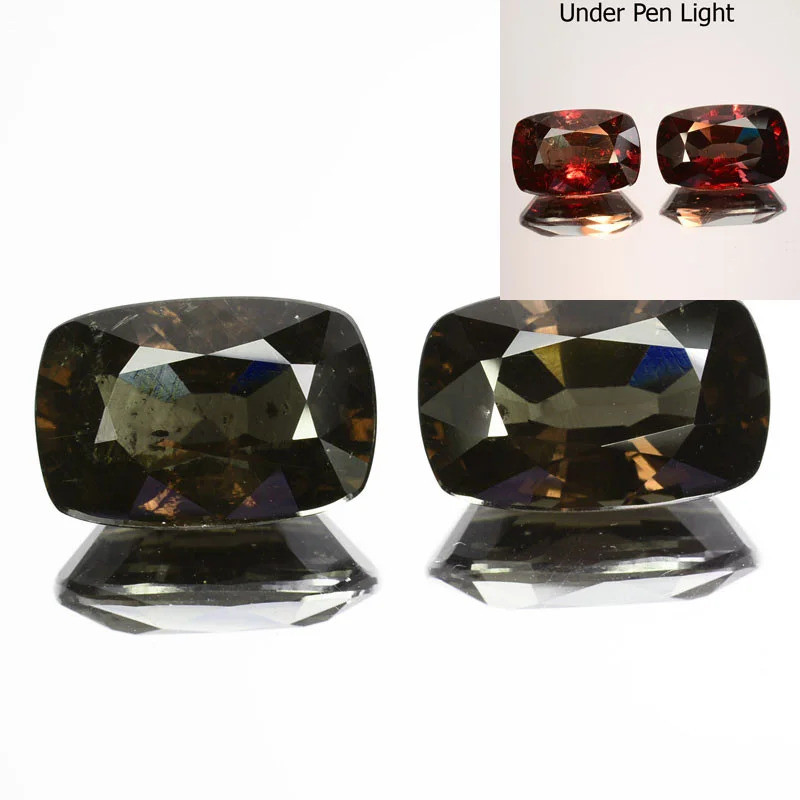 Oben abgebildet: Facettierte Farbwechsel-Granate
Oben abgebildet: Facettierte Farbwechsel-Granate
Metaphysische Eigenschaften des Granats
Die Verwendung des Geburtssteins für Januar als Heilstein hat sich seit der Antike bis in die moderne Kristallheilkunde erhalten.
Viele der metaphysischen Anwendungen des Granats hängen mit seiner Verbindung zu Blut und Herz zusammen, Symbolen für Leben, Stärke und Liebe.
Granat-Geburtssteine sollen die Durchblutung verbessern, das Herz stärken und den Körper von Giftstoffen reinigen, so wie es echtes Blut in unserem Körper tut.
Bei der Energieheilung werden Granate zum Ausgleich aller Chakren verwendet, wodurch die Energie frei durch das gesamte physische, spirituelle und emotionale Wesen fließen kann.
Der Granat, der Geburtsstein für Januar, soll emotional folgendes stärken:
Vertrauen
Hingabe
Bestimmung
Fruchtbarkeit
Widerstandsfähigkeit
Menschen in Beziehungen können von den angeblichen Fähigkeiten des Granats profitieren, die ihnen helfen, sich mit ihrer Verletzlichkeit wohler zu fühlen, negative Gefühle wie Groll oder Wut loszulassen und die Leidenschaft füreinander zu steigern.
Sternzeichensteine für Januar
Zwei astrologische Zeichen fallen in den Zeitraum des Geburtssteins im Januar: Steinbock vom 22. Dezember bis 19. Januar und Wassermann vom 20. Januar bis 18. Februar.
Die Symbolik des Granats für Freundschaft, Wärme und Leidenschaft entspricht seiner Verwendung als Geburtsstein für das Zeichen Wassermann. Wassermänner gelten als leidenschaftliche Menschenfreunde, die Wert auf Freundschaft und Gemeinschaftsbildung legen.
Granate können auch Vertrauen und Hingabe symbolisieren, sowohl romantischer als auch anderer Art, was durch den Spitznamen „Stein der Hingabe“ verdeutlicht wird. Dies passt besser zum Granat als Geburtsstein des Steinbocks. Steinböcke sind hingebungsvolle und zuverlässige Anführer, sowohl im Beruf als auch zu Hause.
Außer Granat gibt es noch einige andere Geburtssteine für den Januar, die Sie kennen sollten.
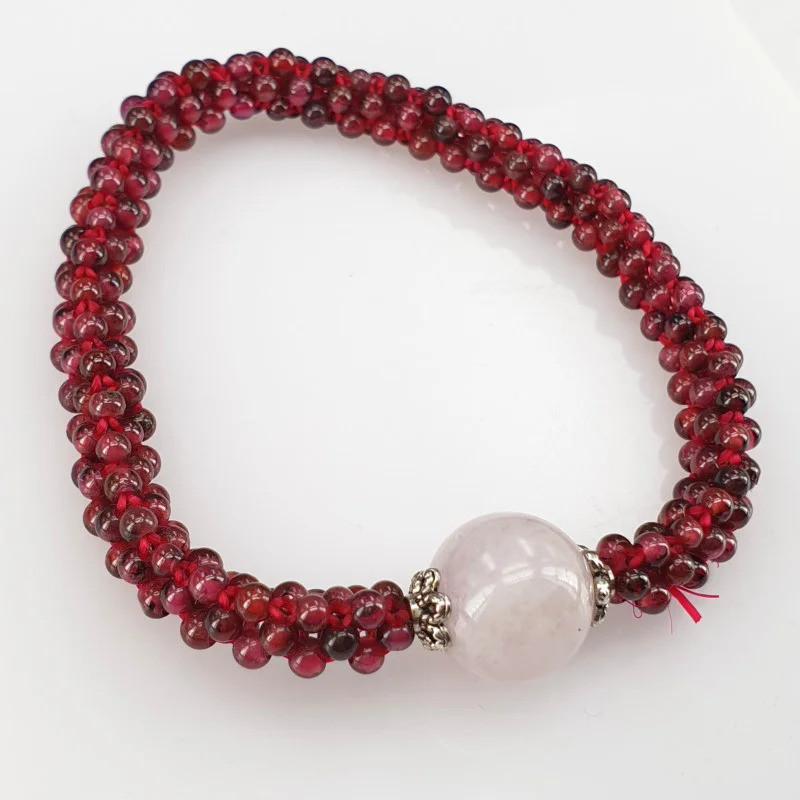 Abbildung oben: Perlenarmband mit Rosenquarz und roten Granaten
Abbildung oben: Perlenarmband mit Rosenquarz und roten Granaten
Alternative Geburtssteine für Januar
Die häufigste Geburtssteinfarbe für Januar ist Rot oder eine Variation davon, beispielsweise Rosa oder Lila.
Der wichtigste Geburtsstein für den Januar, der Granat ersetzt, ist Rosenquarz , eine leichtere Ergänzung zum Feuer des Granats. Diese rosa Quarzvariante ist oft milchig und durchscheinend. Der alternative Geburtsstein für den Januar symbolisiert auch universelle Liebe und Anerkennung.
Der mystische Geburtsstein für Januar ist laut tibetischer Astrologie der Smaragd . Obwohl er sich durch seine grünen statt roten Farbtöne deutlich von anderen Steinen unterscheidet, spiegelt er als Geburtsstein für Januar die Symbolik des persönlichen Wachstums und der Wiedergeburt wider, die mit dem neuen Jahr verbunden sind.
Rosenquarz ist im Vergleich zu Granat weniger haltbar, dafür aber leichter erhältlich. Die beiden Steine ergeben eine tolle Kombination für Januar-Geburtssteinschmuck.
Smaragde sind im Allgemeinen haltbarer als Granate, aber oft auch teurer und von geringerer Reinheit .
Personalisierte Geschenke mit Geburtssteinen für Januar
Obwohl manche die Idee von Geburtssteinen als reinen Marketingtrick betrachten, haben sie eine lange Geschichte und Bedeutung. Tatsächlich geht die Idee der monatlichen Geburtssteine auf biblische Texte zurück.
Geburtssteine sind oft die ersten Kristalle, mit denen Menschen in Berührung kommen. Sie sollen dem Träger Schutz und Glück bringen, doch auf einer weniger spirituellen Ebene sind Geburtssteine auch eine Hommage an das Leben.
Egal, ob Sie Ihre eigenen Geburtssteine kaufen oder sie einem geliebten Menschen schenken, es gibt verschiedene Möglichkeiten, die Geburtssteine für Januar zu verwenden:
Als einzelne Edelsteinkette oder Ohrringe
Auf Schmuck mit dem/den Geburtsstein(en) eines/einer geliebten Menschen
Auf Manschettenknöpfen
Als Teil eines gestapelten Ringsets
Verzieren Sie ein personalisiertes Namensschild
Als geschnitzte (oder Rohkristall-) Raumdekoration
Die Liste ist endlos, also werden Sie kreativ! Schließlich ist es Ihr Geburtsstein, also tragen Sie ihn, wie Sie möchten.
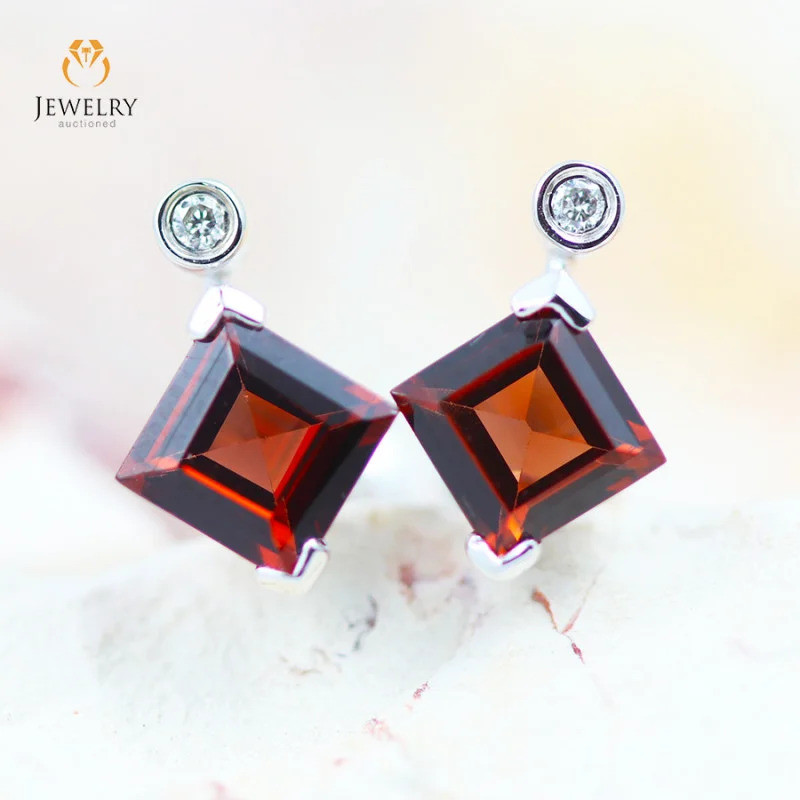 Abbildung oben: Weißgold-Ohrringe mit roten Granaten und weißen Diamanten
Abbildung oben: Weißgold-Ohrringe mit roten Granaten und weißen Diamanten
Feiern Sie Ihr neues Ich mit den Geburtssteinen für Januar!
Wenn du im Januar geboren bist, weißt du, dass du als Startschuss für das neue Jahr und als Spiegelbild der strahlenden Zukunft strahlst – dein Geburtsstein sollte das auch widerspiegeln! Ob du dich für den zeitlos charmanten Granat oder eine Alternative wie Rosenquarz entscheidest – wichtig ist, dass du einen Geburtsstein hast, der dich feiert.
Suche nach Gemstone Encyclopedia
Verwandte Auktionen
In Verbindung stehende Artikel
Jade ist ein wunderschöner Stein, der viele verschiedene Farben haben kann, darunter Grün, Orange und Weiß. Erfahren Sie, wie Sie Jade auf Echtheit prüfen.
9th May 2018
Was sind synthetische Edelsteine, Imitationen und Simulanten? Wir erklären den Unterschied und wie einige davon hergestellt werden.
9th May 2018
Dolomit ist ein weißes bis rosafarbenes oder hellbraunes Mineral mit einzigartig geformten Kristallen, aus denen auch das Dolomitgestein (Dolostein) besteht. Erfahren Sie mehr über die Geschichte, die heilende Wirkung und die Preise von Dolomit-Edelsteinen!
19th Jun 2022
Neue Artikel
Chrysanthemenblütensteine sind Naturwunder mit einem weißen Kalzit-, Celestin- oder Andalusit-Blumenmuster, das sich vom schwarzen Kalkstein oder Tonstein abhebt.
13th Jan 2026
Der Regenbogen-Gitter-Sonnenstein ist eine Feldspatvarietät mit drei wunderschönen optischen Effekten, die durch verschiedene Einschlüsse hervorgerufen werden. Sein feuriges Farbenspiel und das Gittermuster machen ihn zu einem seltenen Sammlerstück!
12th Jan 2026
Thulit ist ein seltener norwegischer Edelstein aus der Zoisit-Mineralfamilie, der einen leuchtend rosafarbenen Farbton aufweist und häufig für Schmuckfassungen und Anhänger verwendet wird.
6th Jan 2026
Artikelkategorien
How To's is where you will find helpful articles from gem Rock Auctions on how to cut gemstones, select gemstones and buy gemstones.
9 Artikel




